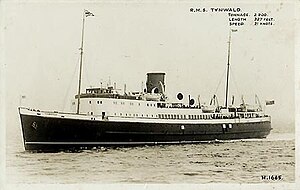HMS Tynwald

RMS Tynwald
|
|
| History | |
|---|---|
|
|
|
| Name: | Tynwald |
| Owner: | 1936–1940: Isle of Man Steam Packet Company |
| Operator: | Isle of Man Steam Packet Company |
| Port of registry: |
|
| Ordered: | 1936 |
| Builder: | Vickers-Armstrong, Barrow-in-Furness, United Kingdom |
| Laid down: | 1935 |
| Launched: | 16 December 1936 |
| Completed: | 1937 |
| In service: | 1937 |
| Out of service: | Transferred to the Royal Navy as HMS Tynwald, late 1940 |
| Homeport: | Douglas, Isle of Man |
| Identification: |
|

HMS Tynwald
|
|
|
|
|
| Name: | HMS Tynwald |
| Commissioned: | 1 October 1941 |
| Fate: | Sunk on 12 November 1942 |
| Status: | War Grave |
| General characteristics | |
| Type: | Passenger steamer |
| Tonnage: | 2,375.53 GRT |
| Length: | 314 ft 6 in (95.9 m) |
| Beam: | 46 ft (14.0 m) |
| Depth: | 18 ft (5.5 m) |
| Installed power: | 8,500 shp (6,300 kW) |
| Propulsion: |
|
| Speed: | 21.7 knots (25.0 mph) |
| Capacity: | 1968 passengers |
| Crew: | 68 |
TSS (RMS) Tynwald No. 165281 was a passenger vessel which served with the Isle of Man Steam Packet Company from 1937 until she was requisitioned for war service at the end of 1940. She was the fourth ship in the line's history to bear the name. Tynwald was sunk in November 1942 off the Algerian coast.
Tynwald and her identical twin Fenella were built by Vickers Armstrong at Barrow-in-Furness and launched on the same day, 16 December 1936.
Tynwald had a gross registered tonnage of 2376t, a beam of 46', a length of 314'6", a draught of 18' and a design speed of 21 knots. Both Tynwald and Fenella, had crew accommodation for 68, and a capacity for 1968 passengers.
Like her sister ship Fenella, Tynwald was intended primarily to be used on the winter service between Liverpool and Douglas.
They were virtually identical apart from slight decorative differences, the noticeable external difference being Tynwald had her upper strake painted white, whereas on Fenella it was black. Spacious lounges were a feature of both ships which were furnished to a high standard.
On 1 October 1937, the Tynwald conveyed the newly appointed Lieutenant Governor of the Isle of Man, Vice Admiral Leveson-Gower from Liverpool to Douglas. The Tynwald was decorated with bunting and flew the Governor's flag from the foremast. She arrived into Douglas at 14:45hrs, signalling her arrival by the blowing of her ship's whistle, which in turn was greeted by rockets being fired from Douglas Head and the sounding of the fog horn on the Victoria Pier.
...
Wikipedia
